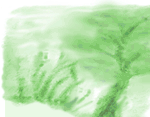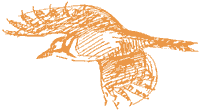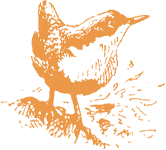



|
|
Winter 1990:
The following article was written by Martin Calvert and originally printed in the RSPB Leeds Local Group Newsletter). It has been reproduced with his permission.
Gledhow Valley Lake is host to a pair of Little Grebes. The birds disappear for a couple of months in Winter and last year the first bird arrived back in early February. At this time, its breeding plumage was beginning to appear and the whinnying trill of the lone bird was frequently heard. A second grebe appeared by the beginning of March and every time the birds were re-united after fishing expeditions their joint jubilant trilling echoed round the lake.
Thus, the lone chick from the first clutch (hereafter known as First Born) was joined only two weeks later (incubation time is 20 days) by four tiny chicks. With five mouths to feed the adult birds were kept busy and the incessant calls of the young birds were a feature of my May grebe-watching. Unfortunately, only one of the second brood survived (hereafter known as the Second Born).
By the end of May First Born was being harassed by the parent grebes as he/she was nearly fully grown and had become an intruder on the territory. However, First Born remained on the lake and was joined by Second Born as the parents started incubating on a new nest in the middle of the lake. Both surviving juveniles kept well away, especially from the adult male and fished together in the remote corners of the lake for a couple of months longer.
By the 26th June a third clutch of eggs had been incubated for ten days. The 27th June was a very wet day with heavy rain falling from 8.oo a.m. onwards, resulting in the nest being swept to the far end of the lake, one yard from the public footpath and just short of the drainage overflow grille. However, the nest settled into position amongst the driftwood and the grebes carried on incubating, covering the five eggs with leaves if trouble approached. All the local dog walkers were alerted to keep a watch on the nest to prevent unnecessary disturbance.
All went well until the 30th when two council men and a van appeared to clear the flotsam and driftwood from the area around the drain. This is a regular occurrence to prevent flooding. I happened to be present as the men appeared and pointed out the nest to them. There were very sympathetic and cleared the debris, being careful not to damage the nest. This work took nearly two hours and rain began to fall as they started. The nest now had no anchor so with a long pole they moved the nest ten yards to the safety of the bank on the far side of the lake and went off for lunch.
My estimate of hatching was on the 6th July and on the 7th one tiny chick duly appeared, joined three days later by a second. The adults and the two chicks left the nest almost immediately and moved to a hastily constructed nest at the other side of the lake. By this time First Born and Second Born had moved on to pastures new, possibly Roundhay Lake.
The two chicks thrived and by the end of August were nearly fully grown and were being chased and harassed by the parent birds. Gradually the adults plumage was changing to the duller Winter garb and one by one the birds left Gledhow for their Winter homes, the last bird being present on the 5th November.
The pair raised four young from eight chicks hatched from approximately fifteen eggs. Just another year in the Little Grebes' Story.
To see how successful the nestboxes have been from the start of the scheme to the present day, please see the Nestbox Records for Gledhow Valley page. If you have any information, stories, pictures or memories you would like to contribute to this section of the web site, please contact us.
|
| ||||||
 | ||||||||
 Nest building began straight away, with trial efforts dotted round the lake. By the middle of March a nest was appearing at a previously successful site. The grebes were incubating by the beginning of April and a chick had hatched by the end of the month. I think that this first clutch of eggs was chilled by flood water at one point, as the birds had laid a second clutch before the first clutch was due to hatch.
Nest building began straight away, with trial efforts dotted round the lake. By the middle of March a nest was appearing at a previously successful site. The grebes were incubating by the beginning of April and a chick had hatched by the end of the month. I think that this first clutch of eggs was chilled by flood water at one point, as the birds had laid a second clutch before the first clutch was due to hatch. Almost straight away the grebes returned to the spot where the nest had been, but despite much pointing and shouts of 'over there' from the two watchers, failed to locate the nest. This was a disaster, four times they returned, but could not spot the nest and it was still raining. Drastic action was required so I waded in (avoiding the leeches), lifted the nest out of the water, carried it round to the area of the drain and re-floated the nest into the original position. We hoped and prayed that the grebes would return once more and sure enough, after five minutes both birds swam down the lake on the surface and underwater, their joyous trilling indicated their successful location of the nest. This was splendid, but the frantic re-building followed for three hours before the nest and eggs could be safely incubated. All this time it was raining and we were worried that the eggs might be chilled. Luckily the nest drifted across the lake to the far bank and settled into a well camouflaged position. Ironically, this was just were the council men had left the nest. By that evening the grebes were sitting tight once more. There was heavy rain overnight, but the re-building job had been thorough and the birds were still incubating the next morning.
Almost straight away the grebes returned to the spot where the nest had been, but despite much pointing and shouts of 'over there' from the two watchers, failed to locate the nest. This was a disaster, four times they returned, but could not spot the nest and it was still raining. Drastic action was required so I waded in (avoiding the leeches), lifted the nest out of the water, carried it round to the area of the drain and re-floated the nest into the original position. We hoped and prayed that the grebes would return once more and sure enough, after five minutes both birds swam down the lake on the surface and underwater, their joyous trilling indicated their successful location of the nest. This was splendid, but the frantic re-building followed for three hours before the nest and eggs could be safely incubated. All this time it was raining and we were worried that the eggs might be chilled. Luckily the nest drifted across the lake to the far bank and settled into a well camouflaged position. Ironically, this was just were the council men had left the nest. By that evening the grebes were sitting tight once more. There was heavy rain overnight, but the re-building job had been thorough and the birds were still incubating the next morning.